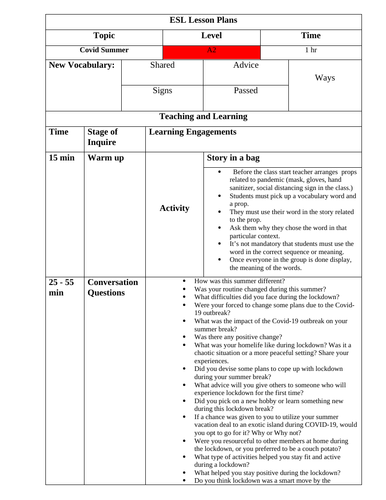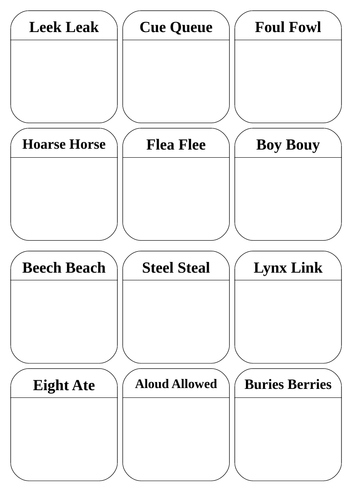
24Uploads
2k+Views
82Downloads

Allegory lesson Plan
This Lesson PPT is based Authorial technique of Allegory.
Students will start by identifying common use of symbolism in writing and
by the end of lesson write using allegory.
Activities
Warm up
AFL
Making Connection
Reading task
Discussion
AFL
Application Task - Written Work
Plenary

Difference between coinage and neologism
This resource provides a clear and concise explanation of the distinction between coinage and neologism. The resource also delves into the various types of neologisms, including coinages, borrowings, blends, acronyms, clippings, semantic shifts, and eponyms.

Traditional Tales - PBL Lesson Plan- Travel the World!
This Project based lesson plan is inspired by a very similar lesson plan i found on the internet “The Amazing Race.” I have not changed the name in my lesson plan activity as I made it a race within the class in groups. The activity provides students to read different types of traditional tales from a specific continent, I limit the number for each group 10. Each group had 5 students so each group had to read 50 traditional tales to win each student had to read 10. So their success depends on their groups’ success. I used stamps as exit tickets for the passport. Please get back to me if something is not clear. I welcome any suggestions to make my resource better.

Covid Summer ESL Speaking Lesson plans
About the Resource
These lesson plan resource is designed keeping in mind CEFR levels for Students.
In this resource pack you will find A2, B1, B2, C1 and C2 level speaking activities, Questions to prompt speaking vocabulary words appropriate for each level and handout if needed for the activity.
Topic: Coivd Summer
Lesson Duration : 1 hr
Vocabulary words (related to the topic.)
Stages of Learning
Warm up activity
Conversation Questions
Grammar Activity (Verbal)
**Additional **
This resource can be used by any native language teacher to be used in ESL classes. All you have to do is add translated words for the vocabulary.

Taking a Vacation - ESL Speaking Lesson
About the Resource
These lesson plan resource is designed keeping in mind CEFR levels for Students.
In this resource pack you will find A2, B1, B2, C1 and C2 level speaking activities, Questions to prompt speaking vocabulary words appropriate for each level and handout if needed for the activity.
Topic: Taking a Vacation
Lesson Duration : 1 hr
Vocabulary words (related to the topic.)
Stages of Learning
Warm up activity
Conversation Questions
Grammar Activity (Verbal)
**Additional **
This resource can be used by any native language teacher to be used in ESL classes. All you have to do is add translated words for the vocabulary.

Interdisciplinary Assignment
The topic used for this assignment is Poetry, with learning objectives and learning outcomes.
This resource includes skills like
Reading
Writing
Problem Solving
Critical Thinking
Research
Grading Rubrics & Self Assessment.
This is ready to use resource with connection to different subjects and U.A.E connection.
I used this resource for year 8, level of difficulty can be adjusted to be used for any year level.

Mastery Cause & Effect Reading, Writing, & Creativity Bonanza!
Unleash the Power of Cause and Effect: A Comprehensive Worksheet for Deeper Understanding
Boost your students’ reading comprehension and writing skills with this engaging, all-in-one cause and effect worksheet!
This powerful resource combines four essential activities, designed to:
**Sharpen reading comprehension: **Dive into a captivating passage where students identify causes and their resulting effects.
Master cause and effect analysis: Guide students through step-by-step exercises to solidify their understanding of cause-effect relationships.
Unlock creative potential: Spark imagination with a fun and thematic creative writing prompt that integrates cause and effect.
Strengthen cause and effect writing: Equip students with the tools to craft clear and impactful cause-effect essays or narratives.
What’s inside:
A thought-provoking reading passage: Captivate students with an interesting text rich in cause-effect examples.
Interactive cause and effect analysis: Guide students to identify, analyze, and explain cause-effect relationships within the passage.
A creative writing prompt: Ignite imaginations with a thematic prompt that encourages students to apply cause and effect in a fun and engaging way.
Cause and effect writing guide: Equip students with step-by-step instructions and examples to confidently write effective cause-effect essays or narratives.
Benefits:
Deeper understanding: Develops critical thinking skills by analyzing the “why” behind events.
Improved reading comprehension: Enhances the ability to identify and interpret cause-effect relationships in text.
Enhanced writing skills: Provides targeted practice in crafting clear and impactful cause-effect writing.
Engaging and diverse activities: Keeps students motivated and learning through a variety of engaging tasks.
Aligned with common core standards: Supports achievement of key reading and writing objectives.

Cause and Effect Challenge Task Cards
Unleash Your Detective Skills: The Cause and Effect Challenge!
Sharpen your critical thinking and become a master of deduction with the Cause and Effect Challenge!
What’s Inside:
Diverse Scenarios: Explore a variety of intriguing situations, from everyday occurrences to historical events.
Boost Your Skills: Hone your analytical thinking, problem-solving, and reasoning abilities.
Who is it for?
The Cause and Effect Challenge is perfect for:
Students: Enhance learning in various subjects like science, history, and language arts.
**Puzzlers and Problem Solvers: **Exercise your brain and flex your mental muscles.
Lifelong Learners: Expand your understanding of the world around you.
Ready to embark on a journey of cause and effect?

Compare and contrast Exit slip
Are you a teacher who like to align everything according to the skill of lesson?
Are you struggling to decipher the intricate layers of compare & contrast texts? This resource is your secret weapon!
Packed with 6 engaging activity questions, it empowers you to uncover the hidden connections and contrasting viewpoints within any text.
**Sharpen Your Detective Skills: **Become a text sleuth, hunting for clues like signal words and contrasting phrases to expose the author’s comparisons.
Visualize the Connections: Craft comparison charts and Venn diagrams, transforming complex ideas into clear, easy-to-understand visuals.
Become a Headline Hero: Summarize each text’s essence in a catchy headline, then combine them for a punchy, contrasting statement.
Quote Quest: Unearth powerful quotes that illuminate the texts’ unique voices and shared perspectives, adding depth to your analysis.
** Unleash Your Creativity:** Write poems, songs, or stories that weave the texts’ elements together, showcasing your understanding in a unique and artistic way.
**Challenge Yourself in the Real World: **Analyze real-world objects or concepts, from electric cars to online learning, applying your compare & contrast skills in practical contexts.
This resource is more than just a list of questions; it’s a treasure trove of engaging activities designed to transform you into a confident compare & contrast text detective. So, grab your magnifying glass, choose your activity, and embark on a journey of discovery!

Literary & language devices and its effects
This resource is designed to help you understand and appreciate the various techniques that authors use to enhance their writing and create a more engaging reading experience. Literary devices are like the spices in a chef’s kitchen, adding flavor, depth, and complexity to the overall narrative.
Within these pages, you will discover a wealth of information about different literary devices, including:
Definitions and examples of common techniques such as metaphor, simile, personification, imagery, and symbolism.
The effects that these devices can have on a text, including creating mood, conveying emotions, and reinforcing themes.

Annotating a text for Author's Craft (EFL 0500)
This resource outlines a structured approach to analyzing a text, focusing on the author’s craft and key components within the writing.
I have developed this resource to teach the students active reading skill of annotating for author’s purpose.
Additionally you will find other active reading annotation to help your students while reading.

Writing a Personal Response (EFL 0500)
This resource provides a step-by-step guide on how to write a personal response to literary text.
It outlines key steps such as engaging with the text, identifying personal connections, developing a thesis, and supporting the response with evidence. Additionally, it offers tips on writing style, organization, and revision.

Evidence Based Reading (Library)
This resource is designed to enhance your understanding of travel writing. Through a guided analysis of a travelogue, you’ll identify and analyze key descriptive and linguistic features.
#travel writing #descriptive features #linguistic features, #travelogue analysis, #reading comprehension, #vocabulary development

Language Analysis Sentence Starters
This resource provides a comprehensive list of sentence starters to help you analyze the language used in a text. By using these prompts, you can effectively identify and discuss various linguistic features, including tone, register, word choice, sentence structure, and context.

Language Analysis Writing Structure EFL (0500)
This resource will guide you through the steps of language analysis, providing you with the tools and knowledge necessary to critically examine and interpret texts. We will delve into the concept of analysis, explore the importance of quoting, and introduce the P.E.T.E.R. paragraph structure as a framework for your analysis.

Paper 3 Section A: Language Change, Texts B & C.
This resource provides a comprehensive overview for approaching quantitative language data in English Language 9039, Paper 3, Section A: Language Change, specifically for Texts B & C.
It emphasizes a structured approach to interpreting and analyzing graphs and tables, a crucial skill for demonstrating understanding of language evolution and usage.
The guide breaks down the process into three key stages
Understanding the Question and Context.
Initial Scan and Overview (Quantitative Analysis).
Detailed Interpretation and Analysis.
Finally, the overview highlights the importance of Language and Terminology, advocating for the use of precise linguistic terminology, evaluative language, and maintaining an academic tone.

Paper 3-Strategic Approach to N-gram
This resource provides a strategic approach to tackling N-gram questions in the AS&A Level English Language 9093/31 Paper 3, specifically focusing on Text C. It comprehensively outlines how to interpret and analyze graphs generated from N-gram data, which depict the frequency of words or phrases over time.
The strategic approach is then broken down into three key stages:
Deconstructing the Question
Initial Quantitative Observation (Describe the Graph)
Linguistic Interpretation (Explain the Why)
Finally, the resource highlights Important Considerations for N-gram Analysis.

Paper 3-Descriptors for Graphs/Tables
This section of the resource underscores the critical role of effective communication in presenting language data analysis. It emphasizes three key pillars for strong academic writing.
Precise Linguistic Terminology for Data Analysis
Evaluative Language
3.How to use this terminology.

AS & A Level English Language 9093 -Vocabulary
As students of AS & A Level English Language 9093 must go beyond the surface level.
This resource provides vocabulary list useful for the course and how to decipher language aspects while analysis.

Homophones- Taboo Cards
I have created and used this resource as a starter activity. Taboo as we know we cannot say the word but describe the words for and have their partners guess the word on the card without using the word itself. I left the second half of the card blank so that the students can pick any one word write 3-5 words that come to their mind and then all those words become taboo.
Here’s how i did this homophone starter game. In each group i gave 4 cards and asked them to collaborate and write words that come to their mind about the words. As students were doing it for first time so they did not have any idea what was this all about. The cards were then collected back a random card was then picked from the deck to be guessed. There is a time keeper each word is given only 1 minute. If a word is guessed they have to come up with the other word which sounds the same but means something else within the given time.





















